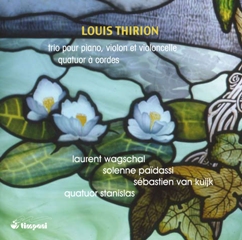MUSICWEB INTERNATIONAL JUNE 2016
Unsung composers don’t come much more unsung than Louis Thirion. Googling his name finds a French Wikipedia page, but also many more references to a recently deceased science-fiction writer of the same name. I can find no reference to other recordings of his music. This certainly bears out the opening remarks in the booklet, which describes the isolation of French composers not working in Paris, whose works would not gain their just recognition.
Thirion was born in the Lorraine region, and educated in Nancy, where he would spend much of his life. His most important teacher was Guy Ropartz, who recognising the talents of his pupil, appointed Thirion as professor of organ and piano at the Conservatory. Thirion’s hometown of Baccarat was seriously damaged during the war, and all his manuscripts were destroyed. His wife died in 1920, leaving him to raise two young children. He stopped composing entirely, restricting himself to teaching. Thus, his creative output is sadly limited to the decade before the outbreak of war.
I have remarked a number of times in my survey of piano trios how a lack of concision detracted from the works of many lesser composers: drawing musical material out too far, so that what qualities there may have been, are diluted. Thirion didn’t fall into this trap: the longest of the eight movements across the two works is a little over nine minutes. The trio is beautifully balanced with all movements between five and seven minutes in length.
Both works are very much of their time and place, but don’t have the sophisticated air of contemporaries such as Ravel and the older Fauré. Nor do they exhibit the cyclic structure popularised by César Franck. This is graceful and elegant music, restrained in a French pastoral style.
The trio is quite a delight, and the best “new” trio I have encountered since that of René de Castéra last year (review). The scherzo (Pas trop vite) is witty and stylish, and the slow movement brings to mind the opening of the Ravel trio. It approaches that degree of beauty, without having the sublime level of passion and intensity.
The quartet, written two years prior to the trio, sounds more modern, especially the outer movements. Their melodies are sharper, more bittersweet with hints of dissonance. Overall, it doesn’t have the immediate appeal of the trio, at least to my trio-leaning ears, but there is no question that it is a very fine work. The Assef vif (scherzo) is wonderfully spicy, with its pizzicato elements.
The playing is uniformly excellent; surely neither group can have seen this music before. Pianist Laurent Wagschal specialises in French music of this period and has made a number of recordings for Timpani, among them the piano works of Emmanuel and Pierné and the chamber music of Magnard; all have been well-regarded. Quatuor Stanislas is a long-established group, based in Nancy. The sound quality is very natural and clean, and the booklet notes are very informative, historically and musically.
Do I have any reservations? Only one: the playing time. Sonatas for piano, cello and violin exist – you can find them at IMSLP. Surely one of these could have been squeezed into the nearly half an hour of “empty space” on the disc. I hope that this means the three of them will be appearing on another disc. In the meantime, I will savour the fifty-two minutes of Thirion that we do have.
David Barker


